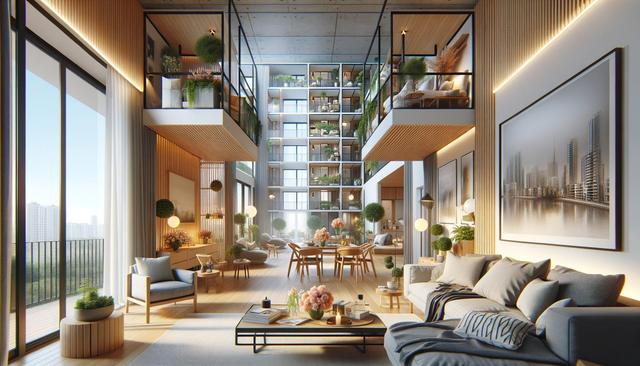Understanding the Local Real Estate Market
When it comes to purchasing an apartment, understanding the local real estate market is a crucial first step. Market trends can vary significantly depending on the neighborhood, city size, and economic activity in the region. Before making any decisions, it’s important to research factors such as average property prices, the supply and demand ratio for apartments, and the long-term value of owning property in your area. Buyers should also consider seasonal fluctuations in prices and availability, as these can influence both the cost and competition for properties.
One helpful approach is to review recent sales data and compare it with current listings. This can provide insight into whether you’re entering a buyer’s or seller’s market. In areas where demand is high, properties may sell quickly and at higher prices, while in slower markets, there may be room to negotiate. Working with a local real estate professional can also provide added context and guidance, especially when navigating price trends and neighborhood-specific insights.
Key metrics to review include:
- Median apartment prices over the last 6-12 months
- Days on market for similar listings
- Rental yield and investment potential
- Projected developments or infrastructure upgrades in the area
Being informed about the local market not only helps you identify fair pricing but also positions you to make smarter investment choices.
Types of Apartments Available
There is a wide range of apartment types available for sale, and understanding the differences can help you find a property that matches your lifestyle and goals. Whether you’re a first-time buyer, a downsizer, or an investor, knowing your options is essential. Apartments vary in size, layout, amenities, and ownership structure, all of which can affect pricing and long-term value.
Common types of apartments include:
- Studio apartments: Compact spaces ideal for singles or young professionals
- One-bedroom units: A popular choice for first-time buyers
- Two-bedroom units: Great for small families or roommates
- Penthouse apartments: Higher-end units with premium views and features
- Loft-style apartments: Open spaces, often with industrial aesthetics
In addition to layout, buyers should consider building amenities such as parking, elevators, security, and recreational facilities. Newer developments may include shared workspaces, gyms, or rooftop lounges, which can add value and convenience. It’s also worth checking the homeowners association (HOA) rules and fees, especially in multi-unit buildings, as these can impact monthly costs and usage rights.
Location Priorities and Neighborhood Insights
Selecting the right neighborhood is just as important as choosing the right apartment. Factors such as proximity to work, schools, public transportation, and local services can greatly influence your quality of life and property value. If you’re buying for investment purposes, areas with strong rental demand, low vacancy rates, and ongoing development can offer better returns over time.
When evaluating a neighborhood, consider the following:
- Safety and crime rates
- Walkability and access to amenities
- Public transit availability
- Community vibe and long-term growth potential
Visit potential neighborhoods at different times of day to get a feel for noise levels, traffic flow, and general atmosphere. Speak with current residents and review local news or community boards to stay informed about any upcoming changes or concerns. Schools, green spaces, and shopping centers are also key indicators of a well-rounded and convenient location.
Ultimately, prioritizing location helps ensure not only comfort and convenience but also solid resale value if you choose to sell later on.
Budgeting and Financing Your Apartment Purchase
Financial planning is essential when searching for apartments for sale. Establishing a realistic budget based on your income, savings, and future goals will make the process more manageable and reduce financial stress. Beyond the purchase price, there are several additional costs to factor into your budget, including legal fees, property taxes, insurance, and maintenance expenses.
Start by getting pre-approved for a mortgage to understand how much you can borrow and what your monthly payments might look like. This not only helps narrow down your search but also shows sellers that you’re a serious buyer. Compare mortgage options from different lenders, taking into account:
- Interest rates
- Loan terms
- Down payment requirements
- Fixed vs. variable rate options
It’s also wise to set aside a contingency fund for unexpected repairs or changes in income. If you’re purchasing an apartment in a managed building, review the ongoing maintenance fees and how they are calculated. Some buildings may have higher costs due to extensive shared amenities or recent upgrades.
Being financially prepared allows you to move forward confidently and avoid surprises down the line.
What to Know Before Closing the Deal
Once you’ve found a property that fits your needs and budget, there are still a few critical steps before finalizing the purchase. Conducting a thorough property inspection is a must, as it can reveal hidden issues that may affect your decision or give you leverage during negotiations. Look for structural integrity, plumbing and electrical systems, and signs of water damage or mold.
It’s also important to review all documents related to the property and building. These may include:
- Title and ownership history
- Building inspection reports
- HOA rules and financial statements
- Warranty coverage if it’s a new build
Work closely with a qualified real estate agent or attorney to ensure all paperwork is in order and deadlines are met. Any discrepancies or unclear clauses should be addressed before signing. Don’t rush the process—taking the time to review everything can help protect your investment and give you peace of mind.
Finally, plan your move and coordinate with service providers early to avoid last-minute issues. Whether you’re moving in yourself or preparing the property for rental, having a clear checklist will make the transition smoother.
Conclusion: Making the Right Move
Buying an apartment is a significant decision that blends personal needs with financial investment. By understanding the market, exploring different types of units, evaluating neighborhoods, and preparing financially, you can approach the process with confidence. Each step—from researching listings to closing the deal—plays a role in ensuring that your purchase aligns with your goals and lifestyle. Take your time, ask questions, and seek professional guidance when needed. With the right planning and insight, finding an apartment for sale in your area can be a rewarding and worthwhile experience.


